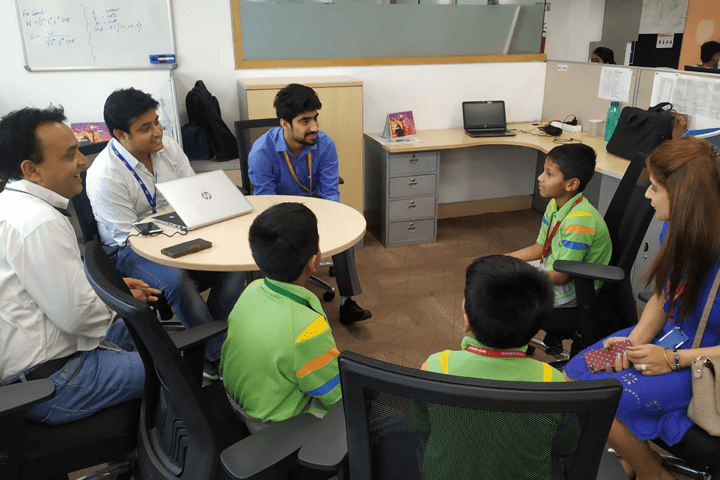MORE THAN JUST WORDS
BY: Amanda Johnson
THE ROLE OF CONVERSATION IN DEVELOPING LANGUAGE SKILLS
A key aspect in stimulating any child’s language development, whether it be their mother tongue or the learning of a foreign language, is to engross them fully in conversation. We know as adults, that having good conversation skills gives us the confidence to stand tall in the crowd but, in this modern world of global digitalization are we actually losing the art of conversing?
The main difficulty with learning any language, is that it just isn’t enriched enough when it comes to holding a conversation, yes we are taught the important building blocks, the rules, vocabulary and the grammar, but it does not begin to tackle the multiplicity of everyday speech…and whilst we are undoubtedly being educated on how we are expected to speak, without conversational skills we are not learning about the way people actually speak.*
An example of this springs to mind. On one of my previous trips to India whilst I was completing an Internship at Manipal University, Karnataka, a young boy joined my table during lunch and proceeded to stare, wide eyed and mouth agape, as I ate my food. Finding this quite off-putting, I scalded him slightly and asked him ‘why he was staring’. His response still makes me smile. Rather than offering the apology I was expecting, he turned to me and said “oh no ma’am, I’m not staring, I’m gawking”!
Gawking is a great word, but unfortunately, it’s not commonly used in the UK anymore…staring or gawking, the meaning is one and the same, was making me uncomfortable which evidently was of no importance to this young boy. However, his choice of words spoken in my native tongue is something I have always remembered from this brief conversation…and consequently ‘gawking’ has since been resurrected within my own vocabulary.
As global technologies rapidly become more and more central in our lives, with an abundance of internet search engines, computer programs, and predictive text all essentially assuming that ‘they’ know what we are trying to say before we actually do, is it any wonder that we and especially our children are displaying uncertainties when it comes to the conversational aspect of language.
The act of conversing is a social connection, whether it takes place at home, the classroom, the market place or in a one on one situation, it not only nurtures the growth of a language…it is a connection which develops a wide range of other skills needed to be a good communicator. The physical conversation expands our ability to listen, it helps us understand and share feelings with each other, it widens our choice of vocabulary thus enabling confidence when speaking with others and, can influence how we recognize our own thoughts and actions. All of which are lacking in the digital era.
A child’s development is a continuum of growth throughout different stages with each phase becoming more and more sophisticated.

The formative years are acknowledged to be the most important in terms of response and interaction. Widely recognized to be the ages between birth and 8, this is the stage of rapid cognitive, social, emotional, and physical developments.
Essentially, it is the first 3-4 years which are a crucial milestone in language development, as this is the initial exposure to the mother tongue and when the natural transition from non-verbal to verbal communication occurs.
There are many ways in which we can begin to stimulate our children in their conversational skills, consistent back-and-forth interaction is a key aspect, especially in the formative years.
Try making storytime interactive, instead of just reading their favorite books with them from cover to cover, mix it up a little and get them to tell you the story through the pictures in the book, or just talk about what’s happening in the pictures to open up a dialogue.
Be creative and makeup stories together taking alternating turns to make up the next line, for example, you could start off with “once upon a time there was a slimy green toad who lived in a…” and have them make up the next sentence. This is a great way to initiate back-and-forth interaction…the story might not make much sense by the end but it’s a good way to get the conversation flowing.
Tongue twisters are a great way to boost a range of words using similar sounds and letters. Not only a fun activity, tongue twisters help in developing clear pronunciation through rapid, repetitive speech. Silly mistakes will definitely be made as they are designed to be difficult, but once mastered, your child will be showcasing their new talent with family and friends.
Come up with a ‘word of the week’ game and ask them to substitute the new word as frequently as possible in their conversations. This will aid in exploring new vocabulary and in making connections between words. An example could be to substitute ‘happy’ for ‘glad or cheery’ and ask them to use it instead in their conversations with you for the entire week.
Never miss an opportunity for conversation time, whether it be in the home, in the car or at the end of the day before bedtime…one of the most precious gifts we can give our children is our undivided attention.
Finally, take a step back sometimes and just listen to what they have to say without interruption or even correcting them. The conversation is not only about having the skills to speak, it’s also about having the ability to listen, to hear and understand another’s perspective and to show that you are interested in what they have to say.
By consciously modelling good listening behaviour ourselves we are inspiring our children to foster meaningful and balanced relationships with those around them.
“When you are listening to somebody, completely, attentively, then you are listening not only to the words, but also to the feeling of what is being conveyed, to the whole of it, not part of it.” Jiddu Krishnamurthy (Philosopher)
*Dewaele, J. M. (2004). The acquisition of sociolinguistic competence in French as a foreign language.





